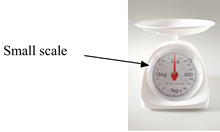Fluid Station LAB 1.2
Fluid Systems in Health Fields
I.V. Therapy

- Lab Goal: To successfully identify concentration levels in urine and to simulate the administration of I.V. therapy.
- Lab Materials Required: All materials listed are supplied.
1. For judging concentration of urine
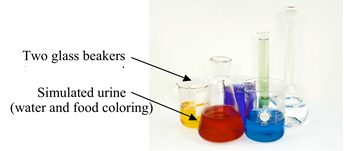
https://creativecommons.org/licenses/by/3.0/
2. For determining weight and density of fluid:
http://en.wikipedia.org/wiki/KilogramTwo beakers filled with simulated urine (colored water)
Calculator
Pencil
3. For I.V. Therapy
Chang Bioscience “I.V. Infusion Practicing Model,” including...
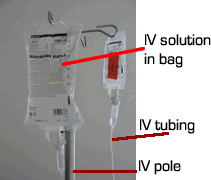
http://en.wikipedia.org/wiki/Intravenous_therapy
- Objectives for Experiment:
IV needle with tubing and connector
Simulation arm section
Gloves
Alcohol Swabs
Pencil
4. Answer Sheet
- Identify urine that is highly concentrated through examination.
- Calculate the density of two fluids of different concentrations.
- Complete the general procedure for IV placement and fluid administration.
- Document the required information on a patient chart.
- Correctly define the terms in bold from the introduction.
- Correctly answer application questions relating to the lab experiment.
- Prerequisite Knowledge: Minimum 6th grade reading level. All instructions provided.
Process Summary: At this station you will…
- Learn to recognize the signs and symptoms of dehydration.
- Examine simulated samples of urine to determine concentration.
- Measure volumes and weights of simulated urine in order to calculate density.
- Set up a basic IV on a simulation arm section.
- Document the IV placement on a simulated patient chart.
- List at least 5 signs or symptoms of dehydration.
- Explain what the urine of a dehydrated person looks like.
- Describe why IV fluids typically contain a low concentration of salt, and why it is not recommended to administer pure water.
Applied Health Terminology: Like many professions, the medical field has its own vocabulary. We have created flashcards to help you learn some of the vocabulary related to joints and movement that was used in this lesson.
You can find these flashcards on the computer at the site below.
Instructions to the flashcard site:
- Click on the link below.
https://quizlet.com/87282657/fluid-station-12-fluid-balance-and-iv-therapy-flash-cards/
- Then click on the “Flashcards” button in the upper left corner of the screen.
- For each card, say the word out loud and try to say what you think the definition is.
- Flip the card by clicking on it and say the definition listed out loud.
Evaluation: Your lab performance will be evaluated by the criteria (standards) you will find in this project’s rubric. A rubric is simply a table that states how you will be evaluated. Your coach will use this table to report your performance.
CLICK HERE TO GO TO THE RUBRIC
_______________________________________
INTRODUCTION
I.V. Therapy Sounds complicated, doesn’t it?
But it really isn’t.
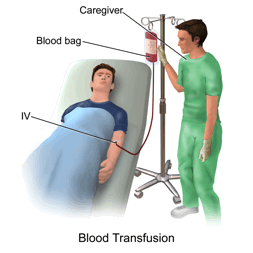
http://en.wikipedia.org/w/index.php?title=Special:CiteThisPage&page=Blood_transfusion&
If you have ever had Intravenous (IV) therapy or have seen someone else getting it, you already know the basics. Fluid (blood or other liquids) from an IV bag is fed through tubing to a needle that is usually inserted into a vein to rehydrate a patient.
Let’s look at why a person may require IV therapy and how it affects the fluid balance in the body.
Exactly what is Fluid Balance?
Fluid balance in the body means the balance between fluids going into the body and fluids going out of the body. This is an important part of maintaining homeostasis (home-ee-oh-STAY-sis), or keeping all systems of the body in balance in order to maintain health.
Did you know?
In women - 52% of their total body weight is water
In men - 60% of their body weight is water
Why is fluid balance so important?
The fluids in the body circulate (SER-cue-late): blood moves through the vessels and other fluids move between the body’s compartments and spaces. Movement between compartments depends on fluid concentration, which is a measure of how much of one substance is dissolved in a certain volume (or amount of space taken up) of some type of fluid.
Concentration is a ratio, which means a relationship between two numbers based on how many times one can go into the other. It is usually written as a fraction.
For example, let’s say you had two jugs of water, each holding a gallon, and you dumped two cups of salt into one but only one cup of salt in the other. Then let’s say you mixed them to make the salt dissolve. The water that you dumped the two cups of salt into would have a higher concentration than the other. It would be written as “2 cups per gallon,” or “2 cups/gallon.” The concentration of the other jug would only be “1 cup/gallon.”
This works with any substance, even other liquids! Check out this range of concentrations of food coloring in water:
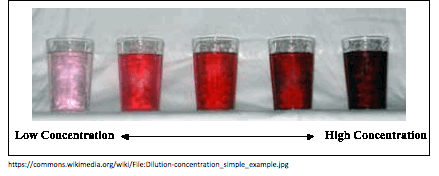
A more concentrated fluid also has a higher density, which is a measure of how much matter (or mass) is occupying a certain volume. When we say “oil is lighter than water,” we should actually be saying “oil is less dense than water.” What this means is that if we have a cup of oil, there is a smaller number of molecules taking up that space compared to a cup of water. This is what makes oil seem “lighter,” and why it floats on top of water. Check out this video to see mass, volume and density explained:
Density is usually measured in grams per cubic centimeter (g/cm3), which is the same as grams per milliliter (g/mL). But density can actually be written with any unit of mass over any unit of volume. Now watch this video to learn 5 fun facts about density:
It would make sense that a more concentrated liquid would have a higher density though, right? In our example above, the water that had 2 cups of salt dissolved in it has more matter in it than the water with only 1 cup in it, and therefore the same volume of liquid actually weighs more. It is more dense.
| Body fluids contain many different substances, but some of the most common of these are a variety of different ions, which are charged particles. These ions allow the body to conduct electricity. This is extremely important in organs like the heart, brain and spinal cord, which depend on electric signals. You have probably heard these ions which are used to conduct electricity through the body referred to as electrolytes. | 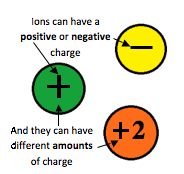 |
The universe is always trying to be balanced, and wants everything to have an equal concentration. When molecules naturally spread out from being clustered together to being equally spread out, this is called diffusion (diff-YOU-jun).
Cells and compartments of the body, however, are separated by semi-permeable membranes (SEM-ee-PER-mee-uh-ble MEM-brains). These are walls made up of many tiny molecules that only allow certain things to pass through, while preventing others from passing through. One thing that can usually pass through fairly easily is water, while other things like most ions cannot. So, the ions are not able to diffuse out and make an equal concentration across the membranes.
On the other hand, since water is able to move through many membranes in the body, fluid tends to move from areas with a low concentration of a substance to areas with a high concentration of that substance until everything is distributed equally - or balanced. Movement of water from an area of low concentration to high concentration across a semi-permeable membrane is called osmosis (oz-MO-sis). Check out this picture:
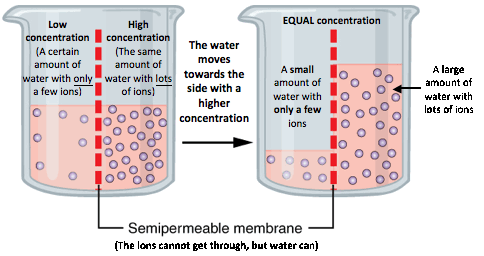
Modified from https://commons.wikimedia.org/wiki/File:0307_Osmosis.jpg
If fluid balance is out of whack, the resulting changes in ion concentrations in the blood and body fluids can cause heart arrhythmias (irregular or abnormal heart rhythms), and neurological problems (functional problems with the brain and spinal cord). So it is not only important to maintain the proper amount of fluid in the body, but it is also vital to maintain the same concentration of ions that are dissolved in body fluids. For this reason, the most common fluid administered through an IV is something called normal saline, which is water with a low concentration of sodium chloride salt (about 0.9%). This preserves the normal concentration of ions within the body’s fluids.
The total fluid in the body normally changes by less than 1% (so it almost stays the same all the time!) Water is taken in through fluids and food. Most of our natural water loss is from urination. Smaller amounts are lost through sweat, breathing and bowel movements.
| When fluid pressure decreases in an area of the body, the brain stimulates the urge to drink and lowers urine output, because it wants to keep in more fluid. On the other hand, when fluid pressure increases in an area of the body, the brain prevents the urge to drink and increases urine output, because it wants to get rid of excess fluid. |
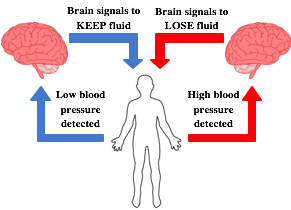 |
Normal urine is clear and straw colored with no sediment (particles that settle to the bottom of a liquid, also called dregs). Concentrated urine is dark yellow, cloudy, has a higher density, and often has sediment. This is because concentrated urine has a lot more waste molecules compared to the amount of water present.
A loss of 0.5 - 1% of the total fluid in the body can cause problems.
This is called negative fluid balance (when the output or loss of fluid is greater than the intake of fluid).
Exactly what is dehydration?
Dehydration is defined as a loss of greater than 1% of total body fluids without replacement.
What can cause dehydration?
 |
Dehydration is caused by inadequate fluid intake and/or excessive fluid loss. Potential ways for this imbalance to happen are: |
- Fever, heat exposure, and too much exercise
- Vomiting, diarrhea, and increased urination (occurs with diabetes)
- Limited access to water and food
- Inability to drink (for instance, someone in a coma or on a respirator)
- No access to safe drinking water
- Significant injuries to skin, such as burns or mouth sores, or severe skin diseases or infections (water is lost through damaged skin)
What are the signs and symptoms of dehydration?
Decreased skin turgor. Turgor is how quickly the skin flattens after being pinched; a decrease means it takes longer. This should happen almost immediately; decreased skin turgor means it “tents” or slowly returns to normal. Click on the video to see normal skin turgor.
Decreased capillary refill. This is a test of blood flow to the arms and legs. Capillary refill is how fast color returns to normal after pressing deeply on the skin or fingernail. Normally this takes only 2-3 seconds. Click on the video to see normal capillary refill.
Other signs and symptoms of mild dehydration are:
- Decreased physical performance
- Headache
- Fatigue
- Sunken eyes
- Decreased urine output
- Increased thirst
- Dry mouth and swollen tongue
- Weakness
- Dizziness
- Confusion
- Sluggishness
- Nausea
Continued dehydration can cause:
- Hypotension (HI-poe-TEN-shun), or low blood pressure
- Tachycardia (tack-i-CAR-dee-uh), or an abnormally fast heart rate
- A weak, thready pulse (a small, fine pulse that you can barely feel; feels like a small cord or thread under the finger)
- Cold hands and feet
- Oliguria (all-ig-YUR-ee-uh), meaning decreased urine output
- Abnormal blood test results
- Fainting
- Inability to sweat
Without treatment, dehydration can lead to life-threatening conditions. Examples include heat stroke, which is when the body cannot get rid of excess heat through sweating, and hypovolemic (HI-poe-vole-ee-mick) shock, which is when the amount of circulating fluids is too small to deliver enough oxygen and nutrients to the body.
Both of these can cause organ failure and death.
Finally, chronic (long-term) dehydration can cause a general worsening of health. This can include long-term fatigue, constipation, high blood pressure, high cholesterol, digestive disorders, skin disorders, joint pain, bladder and kidney problems, asthma and severe allergies, weight gain and even the development of early wrinkles!
After learning all of this information, what do you want to know more about?
What did you find out?
Write one thing you’d like to know more about and one thing you learned on your answer sheet.
Process Summary: In this lab, you will...
- Write observations about the color of two different simulated urine samples.
- Measure the weights and volumes of the simulated urines and use those values to calculate densities.
- Review the medical vocabulary and read instructions on how to place an IV in a simulator arm piece.
- Practice placing the IV and ensure that you have entered the “vein” by checking that the IV solution comes out of the tubing.
- Practice documenting information about the IV placement on an imaginary patient chart.
- Answer application questions related to dehydration.
__________________________________________
Links to Station 1.2. Modules
Lab Intro | Lab Presentation and Practice | Communications Intro| Communications Presentation and Practice| Math
CLICK HERE to go to the Presentation with Instructions for this lab.
